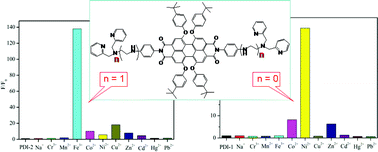Nickel(ii) and iron(iii) selective off-on-type fluorescence probes based on perylene tetracarboxylic diimide†‡
Abstract
Two novel “turn-on”

* Corresponding authors
a
Department of Chemistry, Shandong University, Jinan, China
E-mail:
xiyouli@sdu.edu.cn
Fax: +86-531-88564464
Tel: +86-531-88369877
b Department of Chemistry, Henan Normal University, Xinxiang, China
c
Institut für Chemie und Biochemie, Freie Universität Berlin, Takustrasse 3, Germany
E-mail:
schalley@chemie.fu-berlin.de
Two novel “turn-on”

 Please wait while we load your content...
Something went wrong. Try again?
Please wait while we load your content...
Something went wrong. Try again?
H. Wang, D. Wang, Q. Wang, X. Li and C. A. Schalley, Org. Biomol. Chem., 2010, 8, 1017 DOI: 10.1039/B921342B
To request permission to reproduce material from this article, please go to the Copyright Clearance Center request page.
If you are an author contributing to an RSC publication, you do not need to request permission provided correct acknowledgement is given.
If you are the author of this article, you do not need to request permission to reproduce figures and diagrams provided correct acknowledgement is given. If you want to reproduce the whole article in a third-party publication (excluding your thesis/dissertation for which permission is not required) please go to the Copyright Clearance Center request page.
Read more about how to correctly acknowledge RSC content.
 Fetching data from CrossRef.
Fetching data from CrossRef.
This may take some time to load.
Loading related content
